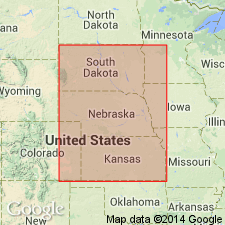
- Usage in publication:
-
- Valentine beds
- Modifications:
-
- Biostratigraphic dating
- AAPG geologic province:
-
- Chadron arch
Summary:
Pg. 170. The 3 phases of Pliocene, in northern and northwestern Nebraska are (ascending) Valentine beds, Snake Creek beds, Devil's Gulch beds.
[Misprint (US geologic names lexicon, USGS Bull. 896, p. 2227): "Notes on the skull of Metoreodon" should be Nebraska Geol. Survey, vol. 7, not vol. 8.]
Source: US geologic names lexicon (USGS Bull. 896, p. 2227).
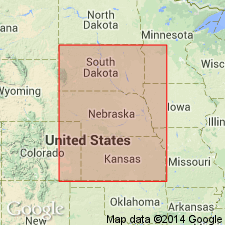
- Usage in publication:
-
- Valentine beds
- Modifications:
-
- Biostratigraphic dating
- AAPG geologic province:
-
- Chadron arch
Summary:
Pg. 173. The Valentine beds are probably a lower phase than either the Snake Creek or the Devil's Gulch.
Source: US geologic names lexicon (USGS Bull. 896, p. 2227).
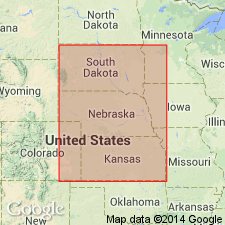
- Usage in publication:
-
- Valentine beds
- Modifications:
-
- Age modified
- Biostratigraphic dating
- AAPG geologic province:
-
- Chadron arch
Summary:
Pg. 23. Valentine beds of Barbour and Cook, 1917, are upper Miocene or lower Pliocene.
Source: US geologic names lexicon (USGS Bull. 896, p. 2227).
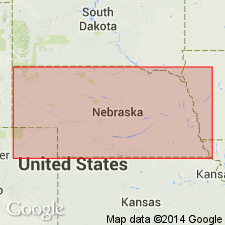
- Usage in publication:
-
- Valentine beds
- Modifications:
-
- Revised
- Biostratigraphic dating
- AAPG geologic province:
-
- Chadron arch
Summary:
Pg. 42-43. Careful systematic collecting in region about Valentine, Nebraska, by R.A. Stirton, P.O. McGrew, and others indicates that at least 3 faunal phases are present in that region, to only the upper one of which the term "Valentine" can properly be applied. The lower member of this section agrees closely with typical "Ft. Niobrara," and there is at least one distinct stage yet to be differentiated. It will undoubtedly be shown that certain beds in Valentine region agree closely with the phase of Snake Creek beds, in which the type of HESPEROPITHECUS was found (on Olcott Hill). If we place beginning of Pliocene at first appearance of HIPPARION, then line between Pliocene and Miocene will occur in Valentine beds.
Source: US geologic names lexicon (USGS Bull. 896, p. 2227).
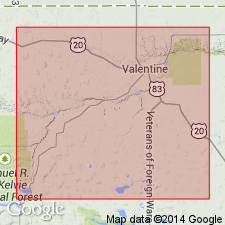
- Usage in publication:
-
- Valentine fauna
- Modifications:
-
- Revised
- AAPG geologic province:
-
- Chadron arch
Summary:
Pg. 125-132. Valentine fauna. Three late Tertiary faunas representing two epochs were found in one formation near Valentine, Nebraska, and following faunal names have been applied: Niobrara River, upper Miocene; Burge, lower Pliocene; Valentine, transitional from lower to middle Pliocene.
Source: US geologic names lexicon (USGS Bull. 1200, p. 4042-4043).
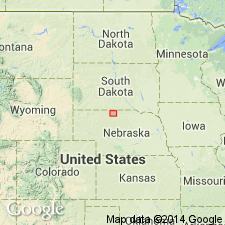
- Usage in publication:
-
- Valentine beds
- Modifications:
-
- [Original reference]
- Biostratigraphic dating
- AAPG geologic province:
-
- Chadron arch
Summary:
Pg. 467-475. Ogallala formation of Valentine area, Cherry County, northern Nebraska, is divisible into: (1) lower Pliocene "cap-rock bed"; (2) lower Pliocene Burge sands (name proposed for the fine- to coarse-grained sands and gravels containing the "Burge fauna"); and (3) Miocene-Pliocene Valentine beds.
Paper reestablishes original and proper usage of name Valentine beds as designating lower part of Ogallala formation of Valentine area, northern Nebraska. Vertebrate fauna from these beds is known as Valentine fauna. Unconsolidated fine-grained sands and clays of Valentine beds are overlain by Burge sands, a name proposed for the fine- to coarse-grained sands and gravels in which Burge fauna typically occurs. Overlying the Burge is the cap rock bed that lithogically resembles typical Ogallala of southwestern Nebraska. Valentine beds are 175 to 225 feet thick and unconformably overlie Brule(?) clay of Oligocene(?) age. Lower part of Valentine beds is composed of loose channel sands, and it is in these beds that Valentine fauna occurs at type locality. In most places, the loose sand is overlain by beds of greenish-gray massive sandstones (upper Valentine beds). These massive sands are not very fossiliferous in Valentine area. The beds were called Fort Niobrara formation by Osborn (1918), but Valentine was used by Thorpe (1922, Am. Jour. Sci., 5th ser., v. 3) and other writers. Simpson (1933, Am. Mus. Nat. Hist. Bull., v. 57, art. 3) recognized Valentine as having priority over Fort Niobrara and more firmly established the name in its correct usage. Name Valentine was first used erroneously when it was applied to upper fauna in area by Cook (1933, Nebraska Geol. Survey Paper, no. 5). Stirton (1933, Amer. Jour. Sci., 5th ser., v. 26, no. 156) assigned name Valentine to upper fauna in region and substituted term Niobrara River fauna for fauna from lower beds (Valentine beds). Usage of term Valentine when applied to upper fauna of area is incorrect. Term Valentine should be used to designate lower beds of area and their included fauna. Type locality designated. [Faunas listed.]
Type locality: on south side of a drainage cut between the old and new RR grades, in NE/4 sec. 17, T. 33 N., R. 27 W., Cherry Co., central northern NE. Named from town of Valentine in Cherry Co., NE.
Source: US geologic names lexicons (USGS Bull. 896, p. 2227; USGS Bull. 1200, p. 4042-4043).

- Usage in publication:
-
- Valentine formation
- Modifications:
-
- Revised
- AAPG geologic province:
-
- Chadron arch
Summary:
Pg. 220-227. Valentine formation. Discussion of Valentine problem and presentation of table of Tertiary stratigraphic divisions acceptable in Nebraska and Kansas. Tertiary is divisible into four lithologic groups (ascending): White River, Arikaree (redefined), Hemingford (new), and Ogallala redefined to include (ascending) Valentine, Ash Hollow, Sidney, and Kimball formations. Valentine formation, in Nebraska, includes STIPIDIUM fossil seed zone; Burge channel member, and "Burge" fauna at top; the true Valentine fauna occurs well down in the formation. Thickness 175 to 225 feet. Overlies Hemingford group which includes Sheep Creek formation at top. [Age is] Pliocene.
Source: US geologic names lexicon (USGS Bull. 1200, p. 4042-4043).
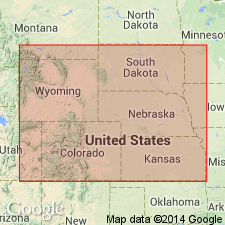
- Usage in publication:
-
- Valentine formation
- Modifications:
-
- Areal extent
- AAPG geologic province:
-
- Chadron arch
Summary:
Pg. 134-139. Valentine formation, lower formation in Ogallala group. In type area, formation is composed largely of unconsolidated layers of greenish silty marl sand and sandy silt and very few local lenses of diatomaceous marl and light bluish-gray volcanic ash. Lowermost described occurrence of mammalian fauna is at so-called Railroad quarries on south side of Niobrara River south of Valentine, Nebraska. This is Niobrara River fauna of Stirton and McGrew (1935). Channel sands from which this fauna has been collected are herein designated Niobrara River channel. Arboreous floral described by Chaney and Elias, 1936 (Carnegie Inst. Washington Pub., no. 476) from lower part of Valentine formation of White Bluff locality occurs in bed of diatomaceous marl herein designated Brown County bed. Highest known fauna in Valentine comes from Burge channel quarries. Seems best not to consider the Burge a channel member of the Valentine, but merely a channel within the undivided Valentine. Underlies Ash Hollow formation. Age is Pliocene.
Source: US geologic names lexicon (USGS Bull. 1200, p. 4042-4043).
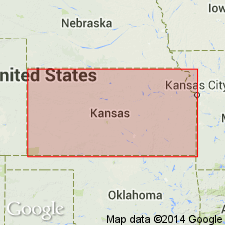
- Usage in publication:
-
- Valentine member
- Modifications:
-
- Revised
- AAPG geologic province:
-
- Chadron arch
Summary:
Pg. 20. Valentine member, uppermost member of Ogallala formation in Kansas. Underlies Ash Hollow member. Maximum thickness 140 feet. Early Pliocene and possibly late Miocene. Major unconformity marks base of Tertiary rocks. They are known to rest on all subdivisions of Comanchean series (Cretaceous) and on Permian redbeds.
Source: US geologic names lexicon (USGS Bull. 1200, p. 4042-4043).
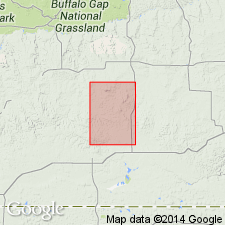
- Usage in publication:
-
- Valentine formation
- Modifications:
-
- Revised
- AAPG geologic province:
-
- Chadron arch
Summary:
Valentine formation. Lower formation in Ogallala group. Consists mostly of light-gray and light-olive-greenish, fine to medium, very poorly consolidated feldspathic or arkosic sand. Estimated thickness at least 175 feet. Grades upward into conformably overlying Ash Hollow formation. Underlies Harrison formation of Arikaree group.
Source: US geologic names lexicon (USGS Bull. 1200, p. 4042-4043).
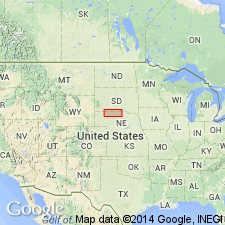
- Usage in publication:
-
- Valentine Formation
- Modifications:
-
- Revised
- AAPG geologic province:
-
- Chadron arch
- Salina basin
Summary:
Pg. 230 (fig. 3), 246 (fig. 4), 250-253, 256-280, 284-293, 294 (fig. 13), 303 (fig. 15), 338-345 (figs. 32-38). Valentine Formation of Ogallala Group. In central northern Nebraska, includes (descending): Devil's Gulch Member, Crookston Bridge Member, and Cornell Dam Member (new). Age is middle to [early late] Miocene (Valentinian NALMA). [On p. 252, authors state Valentinian is applied to faunas that occur in the Valentine Formation and the Valentinian represents a period of possibly 3 m.y. duration. Some paleontologists place the Valentine Formation in the middle Barstovian to early Clarendonian NALMA.]
[See also entries under individual members.]
Source: Publication.
For more information, please contact Nancy Stamm, Geologic Names Committee Secretary.
Asterisk (*) indicates published by U.S. Geological Survey authors.
"No current usage" (†) implies that a name has been abandoned or has fallen into disuse. Former usage and, if known, replacement name given in parentheses ( ).
Slash (/) indicates name conflicts with nomenclatural guidelines (CSN, 1933; ACSN, 1961, 1970; NACSN, 1983, 2005, 2021). May be explained within brackets ([ ]).

